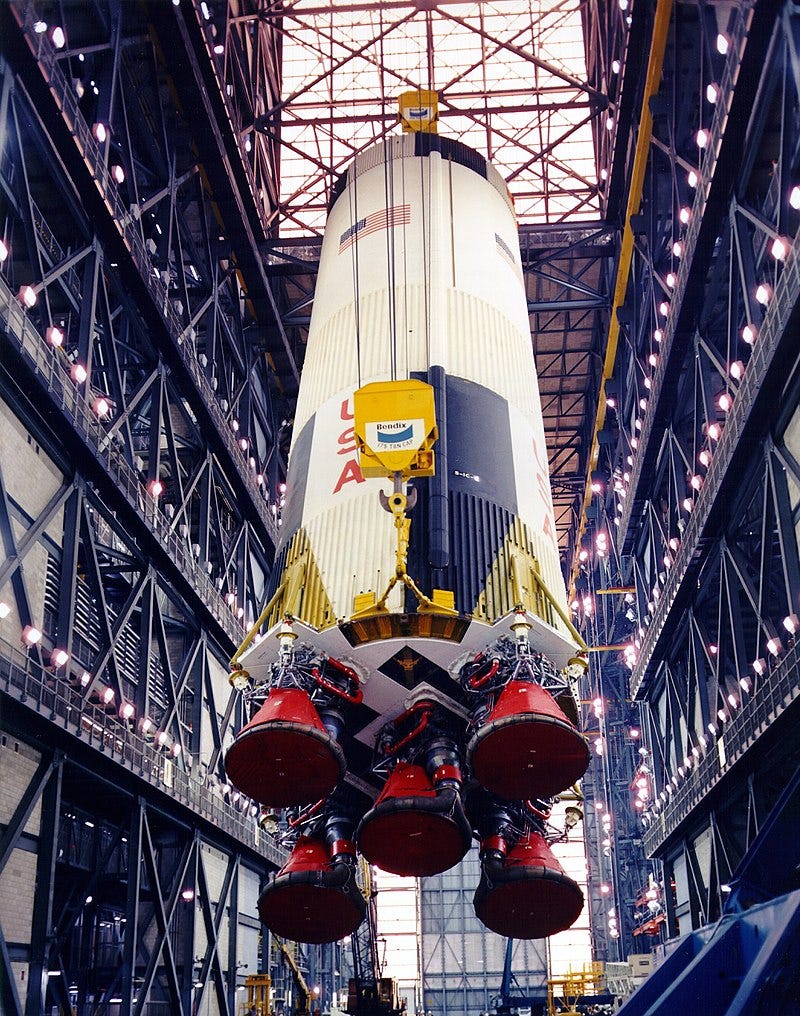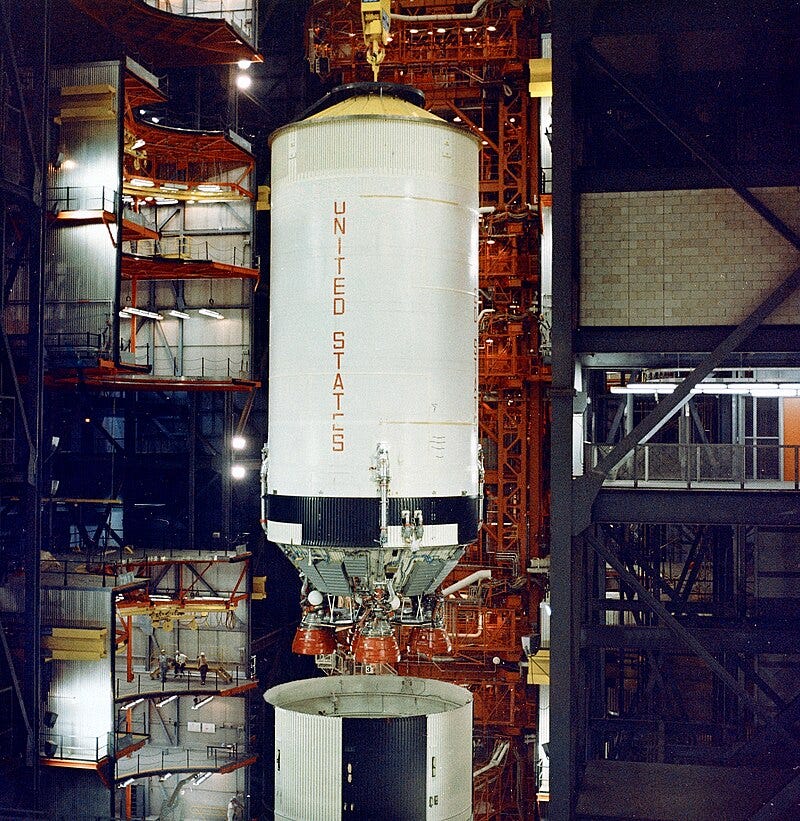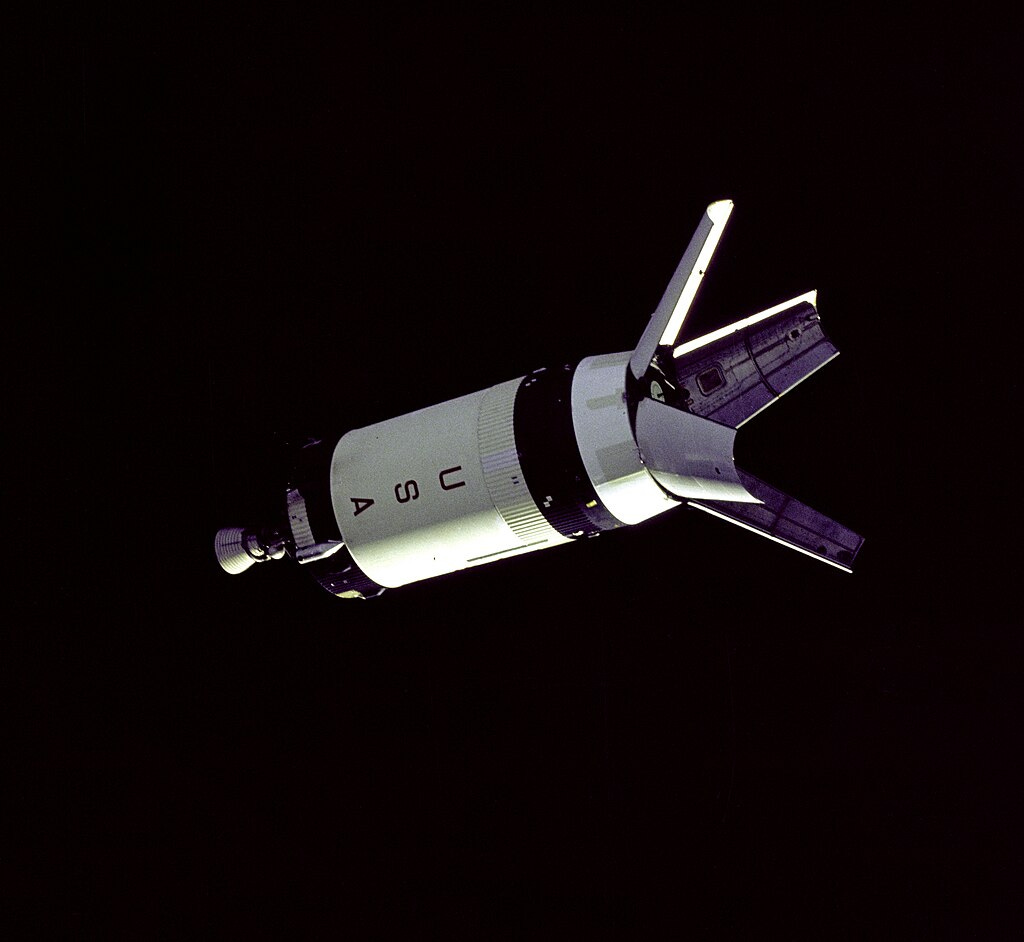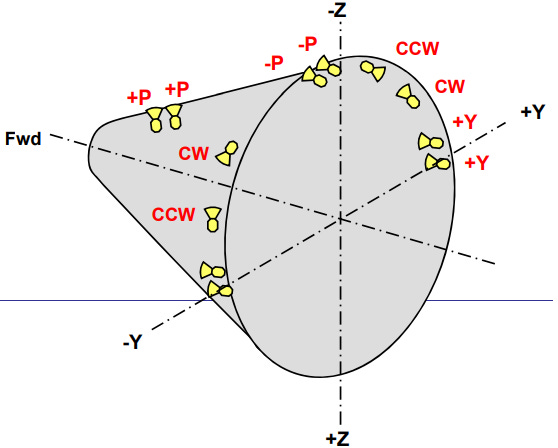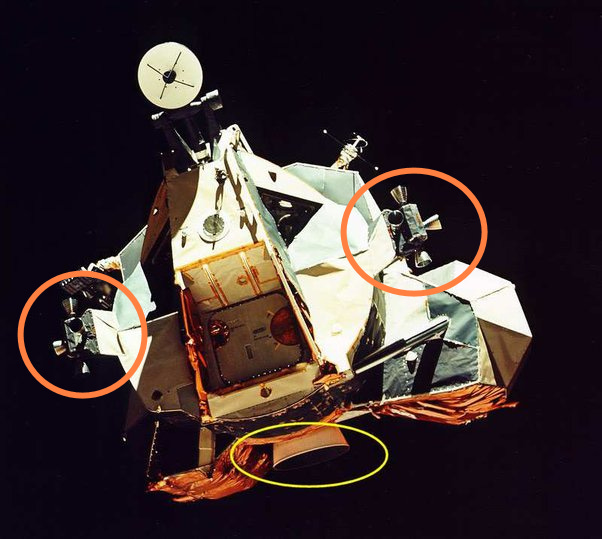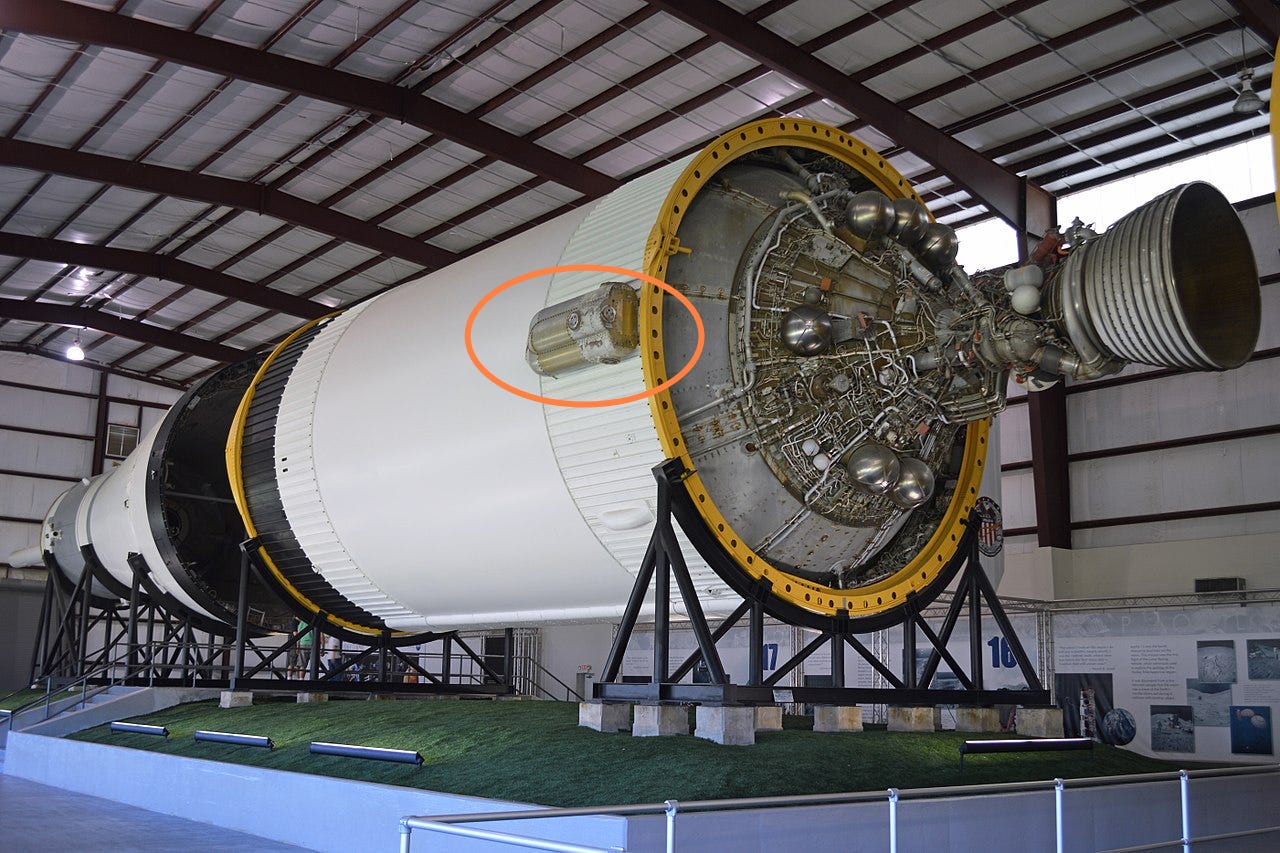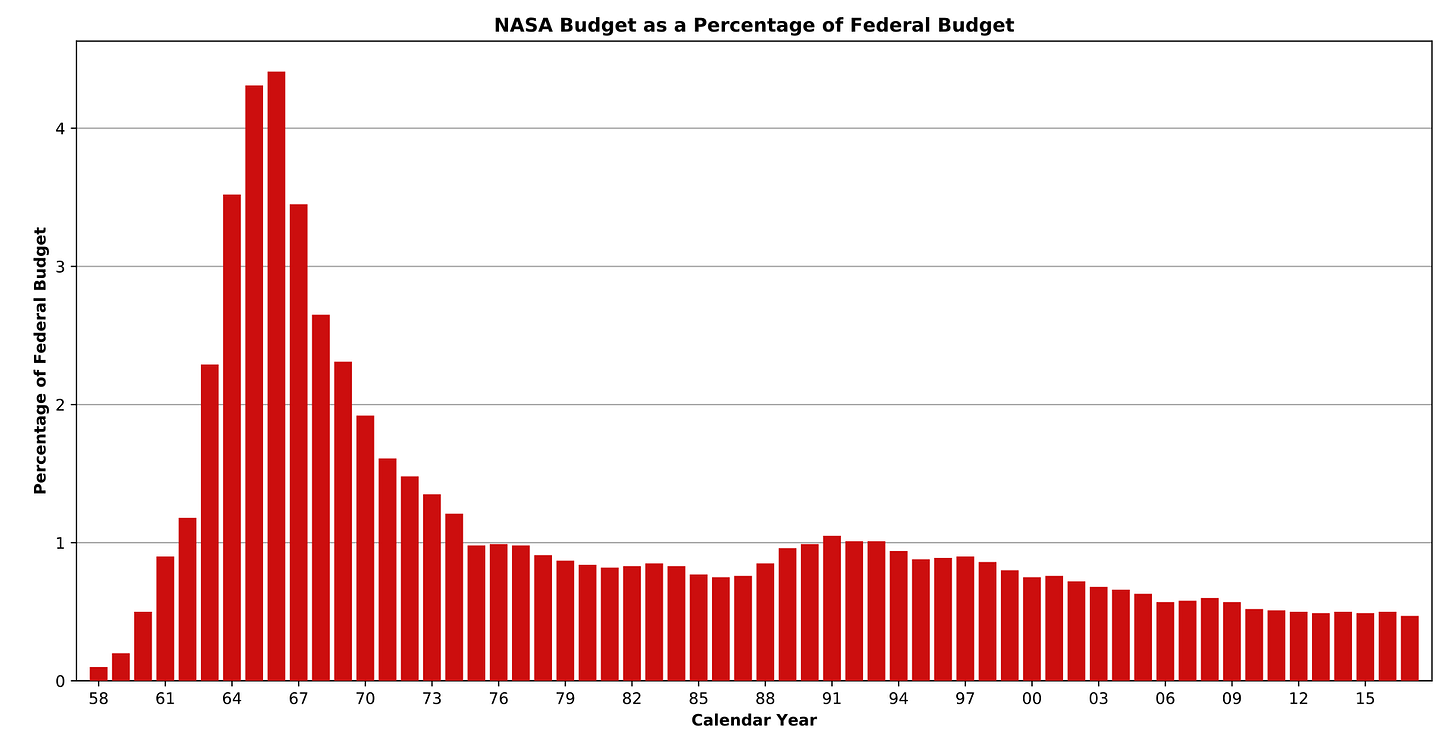Saturn V rocket had how many engines in total?
You would be surprised at the total count!
Question for you all—
The Saturn V rocket was a remarkable feat of engineering, with a variety of engines serving specific functions. In this article, we'll explore the different types and the total count of engines that powered this iconic spacecraft into space.
Before that, take a pause and try to calculate the total count in your head. Or even do it using pen and paper. Count every small and big propulsion system.
Done?
Let’s see if your count matches ours.
First Stage
Engine: F-1 (5)
The F-1 engine is the most powerful single-nozzle liquid-fueled rocket engine ever flown. It was developed by Rocketdyne. The F-1 burned RP-1 (rocket grade kerosene) as the fuel and liquid oxygen (LOX) as the oxidizer in a gas generator cycle. A turbopump was used to inject fuel and oxygen into the combustion chamber. During their two-and-a-half minutes of operation, the five F-1s propelled the Saturn V vehicle to a height of 68 km and a speed of 9,920 km/h. Each F-1 engine had more thrust than the three Space Shuttle Main Engines combined, producing 7,770 kN of thrust in vacuum.
Sixty-five F-1 engines were launched aboard thirteen Saturn Vs, and each first stage landed in the Atlantic Ocean.
Second and Third Stage
Engine: J-2 (5 + 1)
The J-2 engines made the Saturn V’s stage 2 the largest cryogenic stage until the launch of the Space Shuttle in 1981. It burned cryogenic liquid hydrogen (LH2) and liquid oxygen (LOX) propellants, with each engine producing 1,033.1 kN of thrust in a vacuum. Five of them were used in the second stage and one was used in the third stage.
The engine was designed to be restarted once after shutdown when flown on the third stage. The first burn, lasting about two minutes, placed the Apollo spacecraft into a low Earth parking orbit. Then after around one and a half revolutions around the earth, the J-2 was re-ignited for translunar injection, a 6.5-minute burn which accelerated the vehicle to a course for the Moon.
Service and Command Module
AJ10-137 Service Propulsion System (SPS) engine (1)
AJ10-137 engine was a variant of the AJ10 engine, manufactured by Aerojet Rocketdyne. It is a hypergolic rocket engine that uses Aerozine 50 as fuel and nitrogen tetroxide (NTO) as an oxidizer to produce 91 kN of thrust. These propellants were pressure fed to the engine by 1.11 cubic meter of gaseous helium. The engine was used for mid-course corrections between the Earth and Moon, and to place the spacecraft into and out of lunar orbit. It also served as a retrorocket to perform the deorbit burn for Earth orbital flights.
Reaction control system: R-4D Thrusters (4x4)
Four clusters of four reaction control system (RCS) thrusters (or quads) were installed around the upper section of the SM every 90° segment. The sixteen-thruster arrangement provided rotation and translation control in all three spacecraft axes. Each thruster was an R-4D engine designed by Marquardt Corporation. It measured 30 cm long by 15 cm diameter, generated 440 N of thrust, and used helium-fed monomethylhydrazine (MMH) as fuel and nitrogen tetroxide (NTO) as the oxidizer.

It is to be noted that the 4 clusters of the thrusters had inbuilt redundancy, only two adjacent functioning units were needed to allow complete attitude control. These same clusters were also used in the RCS of the Lunar module ascent stage.
Command Module RCS Thrusters (4x3)
The CM RCS consisted of two similar and independent subsystems, identified as subsystem 1 and subsystem 2. Both subsystems were pressurized simultaneously.
In the event a malfunction develops in one subsystem, the remaining subsystem has the capability of providing the impulse required to perform necessary pre-entry and entry maneuvers. In total, there were 12 SE-8 thrusters, that were contained entirely within the CM and each reaction engine nozzle was ported through the CM skin. It also used helium-fed monomethylhydrazine (MMH) as fuel and nitrogen tetroxide (NTO) as the oxidizer. It was capable of generating a thrust of 411 N.
Lunar Module
Lunar Module Ascent Propulsion System (16 + 1)
Along with 16 RCS thrusters, the ascent stage also had a fixed-thrust hypergolic rocket engine developed by Bell Aerosystems. It used pressure-fed Aerozine 50 fuel and nitrogen tetroxide (NTO) as the oxidizer. It was capable of providing 16 kN of thrust.
Lunar Module Descent Propulsion System (1)
The LM’s descent stage used a variable-throttle hypergolic rocket engine invented by Gerard W. Elverum Jr and developed by Space Technology Laboratories (TRW). It used Aerozine 50 fuel and nitrogen tetroxide (NTO) as the oxidizer. It was capable of providing 47 kN of thrust, with an ability to throttle between 4.7 kN to 30.4 kN of thrust.
Launch Escape System
Pitch motor (1)
A rocket engine or pitch motor is present to direct the CM off a straight path and to the side during an emergency. This results in moving getting away sideways from the possibly exploding rocket below.
Launch escape motor (1)
The main solid-fuel rocket motor pulls the CM rapidly away from a launch emergency.
Tower jettison motor (1)
A smaller solid-fuel motor with two exhaust nozzles is mounted in the tube, above the escape motor. This jettisoned the entire Launch Escape System after it was no longer needed, sometime after second-stage ignition.
Ullage motors and retro-rockets (30)
Saturn V had multiple Ullage motors which are relatively small, independent, and solid fuelled motors that may be fired before the main engine firing. This is done because during stage separation the upper stages of the rocket face a momentarily zero gravity condition which can cause the propellants to move and cause disruption in the continuous flow to the propellant pumps. The firing of these ullage motors results in an acceleration causing propellants in the rocket's main tanks to settle towards the aft end, ensuring uninterrupted flow to the fuel and oxidizer pumps.
Saturn V also had multiple small solid-fueled retro-rockets, which were used to push down the S-IC and S-II stages off from the rest of the vehicle after their respective shutdowns during the rocket’s journey from launch to the Earth’s orbit.
Total count: 91
The Saturn V rocket's grand total of 91 engines is a testament to the extraordinary precision and planning that went into its creation. It stands as a remarkable achievement, especially considering it was designed and built in the 1960s and 70s. What's truly inspiring is that despite the technology of its time, this rocket never faltered on its mission to the moon. It reminds us that with dedication, innovation, and a shared vision, humanity can achieve incredible feats that stand the test of time. The Saturn V's legacy will continue to inspire generations as we reach for new horizons in the ever-advancing realm of space exploration.
Which other rocket inspires you the most?
Answer to the question asked at the start: NASA’s budget has been around 0.5% and less than 1% since 1992



